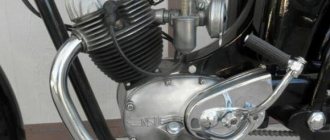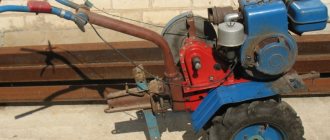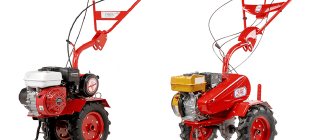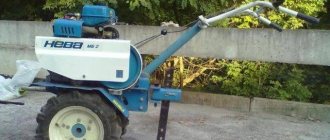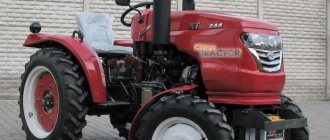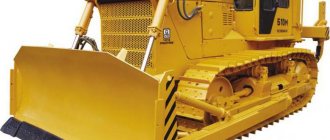Device
The classic walk-behind tractor engine is a single-cylinder, four-stroke internal combustion engine.
Engines
The crankshaft of this engine is mounted in two ball main bearings and, on one side, has a landing cone for the flywheel, also known as an ignition rotor and cooling fan, and on the other, a conical or cylindrical fit for a pulley or clutch.
The connecting rod of a walk-behind tractor is a detachable structure that works directly along the crankshaft journal as a plain bearing.
The friction pair is lubricated by an oil-catching protrusion on the bottom cover of the connecting rod; forced oil supply from the pump is not provided.
The cylinder is installed at a slight angle to the horizontal, its cooling jacket is cast integrally with the crankcase, and a cast-iron sleeve is pressed into it. This solution reduces the cost of engine production, but makes its repair more difficult, since replacing the cylinder is impossible.
The cylinder-piston group is lubricated by oil splashes created by the connecting rod and the crankshaft counterweights as it rotates. First of all, you need to know what kind of oil to pour into the walk-behind tractor, what kind of oil is poured into the gearbox and into the 4-stroke engine.
For more information about the operation of a single-cylinder engine, watch the video:
Depending on the layout of the gas distribution mechanism, the engine can be:
- Overhead valve (SV) - the camshaft is located in the crankcase and, through short pushers, directly drives the valves located on the side of the cylinder. The cylinder head in such engines is a simple casting with a combustion chamber of a specific (cardiod) shape.
- The bottom valve arrangement is the oldest used in our time, it is almost a hundred years old. Due to their extreme simplicity, such motors are cheap and reliable, but their main drawback is their low power density.
- The incorrect term “side-valve engine” is also often used, which appeared as a literal translation of the English side-valve due to ignorance of the term “lower-valve”, which has been adopted in Russian since the 30s of the twentieth century.
- Overhead valve (OHV) engines also have a camshaft mounted in the crankcase, but the valves themselves are already in the cylinder head and are actuated by long rods through rocker arms.
- Due to the more compact and advantageous shape of the combustion chamber, overhead valve engines are noticeably more powerful than lower valve engines, but at the same time they are easy to assemble and configure. This is the most common type of motor in garden equipment.
- Overhead (OHC) engines differ in that the camshaft is moved to the cylinder head. They are more complex compared to OHV engines, and they gain in power only at high speeds, which is of little relevance for walk-behind tractors. Nevertheless, some manufacturers, for example Subaru-Robin, use this scheme.
Engines of relatively large volume (from 200 cm3, as well as diesel) have a manual or automatic decompressor as part of the gas distribution mechanism - a device that at low speeds increases the opening time of the exhaust valve, thereby reducing the effort to manually start the engine.
Correct assembly of an active tiller for a diesel walk-behind tractor
Let's look at the assembly of an active rototiller using the Garden Scout GS81D(E)-GS101D(E)-12DE model as an example.
- We install the knives into special mounts on the hub. When rotating, the knife should go deep into the soil with the sharpened side. We place the hubs with anthers opposite each other. First we install the knife located close to the boot. The curved part of the knife should be directed towards the gearbox, and its pointed part should be directed towards the movement of the cutter.
- We install other knives by analogy with the first. Then we prepare the gearbox. We install the stop on the lower part of the gearbox and secure it with bolts.
- Between the drive gear and the stop, in the center of the gearbox, install a chain tension screw.
- Next, install the hubs with knives on the gearbox. The fixing bolt, which is located on the hub, must coincide with the hole in the splined shaft of the gearbox.
- We install studs into the hubs and screw them into the gearbox shaft.
- We install the casing on the gearbox and attach it with bolts. An important part of the cutter is the wheel, which regulates the depth of cultivation and attaches the adapter seat. The wheel fork is installed on the mounting beam of the cutter. The wheel height adjustment knob is mounted on top of the fork.
- The adapter beam is attached to the fork, and the adjustment spring is tensioned between them. It does not allow the fork with the wheel to rotate freely, returning it to its working position.
skiy
Engines made in China
Chinese motors for walk-behind tractors are most common on budget vehicles and can differ noticeably in quality.
Chinese motor
If units from major manufacturers (Lifan, Zongshen) copied from the Honda GX are close to the Japanese original in quality and durability, then cheaper ones, often not even labeled by the manufacturer, still retain the famous lottery “Chinese quality”.
Many manufacturers of cheap walk-behind tractors, when ordering such motors, put their brand markings on them.
Let's look at the most common types of engines (since the same engine can be produced by a dozen companies, it is pointless to distinguish Chinese engines by brand in this regard):
160F
The lowest power (4 hp) engine for light walk-behind tractors and cultivators. The model for its creation was the Honda GX120 engine.
It is also the cheapest Chinese motor - it costs no more than 5-6 thousand rubles.
168F
The most popular engine model copied from the Honda GX160. This is a gasoline engine with a power of 5.5 horsepower and a displacement of 163 cm3.
Thanks to its simple and reliable design, this motor can be found on walk-behind tractors, cultivators, gas generators, motor pumps and many other units with gasoline engines.
Mini-class equipment is widely used in personal plots and even in public utilities. Mini tractor Bulat 120 is an indispensable assistant for farmers and summer residents.
The chainsaw has become an indispensable and important tool in the daily life of every owner. Here are the causes of malfunctions and repairs of the Husqvarna 137 chainsaw.
Lawn mowers have become one of the most popular tools for lawn work. Here are all the main characteristics of the Champion lawn mower.
This engine can only be started with a manual starter. The gas distribution system is OHV; thanks to the successful layout, adjusting the valve clearances is very simple and quick. The engine can be additionally equipped with an oil level sensor and a generator light winding.
Produced by almost all Chinese factories: Lifan, Zongshen, Loncin and so on. The price can range from 5 to 9 thousand rubles, depending on the manufacturer and additional equipment: reduction gear, oil level sensor, and so on. The Lifan engine is installed on the Mole, Lifan, Oka walk-behind tractor.
Zongshen
168F-1, 168F-2
A more powerful version of the 168F engine, a copy of the Honda GX200. Thanks to the volume increased to 196 cm3, it develops 6.5 hp. Otherwise, it is a complete analogue of the 168F motor.
The price is a little more expensive, depending on the manufacturer, it can be 8-10 thousand.
170F
A seven-horsepower version of the 168F engine, which has no direct analogue in the Honda GX family. The working volume is 212 cm3 (in fact, this is a slightly bored out 168F-1 engine). The piston from this motor can be used when repairing a 6.5 hp motor, since repair dimensions are not provided by the manufacturer.
The thickness of the cast iron sleeve on most Chinese engines allows this.
The price range is the same - from 8 to 10 thousand rubles.
177F
A fairly powerful (9 hp) gasoline engine, which can be found on heavy walk-behind tractors and mini tractors. Copied from Honda GX270.
Price – from 15 to 18 thousand.
182F
An eleven-horsepower engine with a displacement of 340 cm3, similar to the Honda GX340. In the line of most manufacturers of motors for walk-behind tractors, this is the most powerful motor produced.
Price – from 17 to 19 thousand rubles.
170F(A), 170FE, 170FS
A diesel engine for a walk-behind tractor, the price of which, depending on the configuration, is 26-34 thousand rubles. The working volume of these engines is 211 cm3, the developed power is around 4 horsepower. Thanks to the lubrication of the crankshaft under pressure, these engines have a noticeably longer service life than gasoline engines, although they are significantly more expensive.
The letter E in the model designation (as in Chinese gasoline engines) means the presence of an electric starter and, accordingly, a 12-volt generator coil.
How to break in a diesel walk-behind tractor, instructions
When buying a walk-behind tractor, we check it for: the presence of oil in the crankcase (quantity and brand), the inclusion of all gears, how the lights work, the complete set, what is the sound of the engine, are the wheels the same, do the unlockers work, do the control rods match (they may not be the same lengths and different), etc. After that, we bring the walk-behind tractor home.
Add oil to the required level, the brand that the seller filled. If this oil does not suit us, we completely change it to another. It is possible to use mineral diesel oil specifically for break-in. Pour antifreeze into the radiator.
- Tighten the bolts securing the frame to the gearbox.
- We remove and disassemble the clutch pulley. Add grease to the bearings.
- Remove and disassemble the fan tension roller. Add grease to the bearings.
- We adjust the handles to suit your height. We fix it at this height.
- Adjusting the brake and clutch.
- We tighten the belts and adjust the alignment of the pulleys.
- For unlockers, we adjust the length of the rods. Also, with the engine running, we adjust the length of the throttle rods.
- We set the wheels the same way.
- At the support stand we adjust the traction.
- We stretch the cable to the handicap switch and connect it.
After preparing the walk-behind tractor, we proceed to running-in
We start the walk-behind tractor and let it run for 5 minutes at idle. Let it cool and restart for another 15 minutes. Let it cool and increase the time to 20-30 minutes. Let it cool. Having installed the trailer, we start driving without increasing the engine speed above average. At the same time, we monitor the temperature, oil pressure, average speed and exhaust from the pipe.
Let the engine cool often. During breaks, check again all the bolts, fastenings, and settings of the walk-behind tractor.
The main rule when running in a walk-behind tractor is not to overheat the engine, do not increase the speed above average.
After break-in, you need to drain all the oil, rinse the engine completely, and fill in new oil. When starting work, do not install the cutter immediately.
GreenField
The “GreenField” trademark belongs to the Russian TechnoGroup LLC. Since 2005, under it, a variety of garden equipment, gas-powered tools, and power electrical equipment have been supplied to the Russian market.
When buying a motor for a Greenfield walk-behind tractor, you need to understand that the Russian brand in this case is simply applied to a Chinese product, the selling company only carries out quality control on the products supplied to it from China.
Naturally, Greenfield engines, like other Chinese products, are either completely copied from Honda GX engines (GreenField GF series), or based on their design with minor changes (GreenField PRO). However, PRO engines do not have options with an electric starter or reduction gearbox.
The company also supplies diesel engines with power from 2.8 hp. (GF170F) up to 11 hp (GF188FDE). Prices vary quite a lot between stores, but in general they are comparable to Lifan motors.
GF series motors:
| Model | Volume, cm3 | Power, hp | Electric starter |
| GF154F | 80 | 2.9 | No |
| GF168F | 163 | 5.5 | No |
| GF168FE | 163 | 5.5 | Yes |
| GF168F-1 | 196 | 6.5 | No |
| GF168FE-1 | 196 | 6.5 | Yes |
| GF170F | 210 | 7.0 | No |
| GF170FE | 210 | 7.0 | Yes |
| GF173F | 242 | 8.0 | No |
| GF173FE | 242 | 8.0 | Yes |
| GF177F | 270 | 9.0 | No |
| GF177FE | 270 | 9.0 | Yes |
| GF182F | 337 | 11.0 | No |
| GF182FE | 337 | 11.0 | Yes |
| GF188F | 389 | 13.0 | No |
| GF188FE | 389 | 13.0 | Yes |
| GF168F-1 (12V) | 196 | 4,8 | No |
GF motors with reduction gear:
| Model | Volume, cm3 | Power, hp | Electric starter |
| GF168F-R | 163 | 5.5 | No |
| GF168FE-R | 163 | 5.5 | Yes |
| GF168F-1R | 196 | 6.5 | No |
| GF168FE-R1 | 196 | 6.5 | Yes |
| GF170F-R | 210 | 7.0 | No |
| GF170FE-R | 210 | 7.0 | Yes |
| GF177F-R | 270 | 9.0 | No |
| GF177FE-R | 270 | 9.0 | Yes |
| GF188F-R | 389 | 13.0 | No |
| GF188FE-R | 389 | 13.0 | Yes |
PRO series motors:
| Model | Volume, cm3 | Power, hp |
| PRO-4.0HP | 118 | 4.0 |
| PRO-5.5HP | 163 | 5.5 |
| PRO-6.5HP | 196 | 6.5 |
| PRO-7.0HP | 210 | 7.0 |
| PRO-8.0HP | 242 | 8.0 |
| PRO-9.0HP | 270 | 9.0 |
| PRO-11HP | 337 | 11.0 |
| PRO-13HP | 389 | 13.0 |
Greenfield diesel engines:
| Model | Volume, cm3 | Power, hp | Electric starter |
| GF170F | 211 | 2,8 | No |
| GF178F | 296 | 4,2 | No |
| GF186F | 406 | 9.0 | No |
| GF170FE | 211 | 2,8 | Yes |
| GF178FE | 296 | 4,2 | Yes |
| GF186FE | 418 | 6,71 | Yes |
| GF188FDE | 455 | 11.0 | Yes |
What problems might you encounter?
The biggest problem with all Chinese engines is the quality of the material and very poor assembly. And the key word here is savings.
The main parts, cast from poor quality metal, break so that it is useless to weld them. Only replacement saves. They save on everything: on materials, equipment, the amount of soot in the seals. The use of poor quality plastic leads to quick breakage of levers, pawls, start lock, and fuel filter. Poor quality fuel hoses are the bane of all Chinese manufacturers.
There are legends and jokes about the manner in which Chinese engines are assembled. The factory may forget to install a key. Very often the plugs on the gearboxes are not tightened, something is not screwed on, something is not completed, something is not stretched, the bolts are not seated on the sealant, there are gaps.
Ideally, before operation, you need to disassemble the gearbox, double-check everything, and then put it back together properly. Then you can WALK for a while without expecting any unpleasant surprises.
Example: I just got out on the water and the engine stalled. Upon opening it, it was discovered that there was water in there, because the seal was completely missing. There is no compression in the engine. Or the fuel pump does not pump because the required hole is not drilled in the carburetor. And there are not even a few such cases. And changing the oil in the gearbox is generally a must-do for everyone, and more often than not it’s not even changing, but filling it in, since it’s not there a priori.
Caring dealers sometimes even put reminder stickers about this. Despite the fact that this procedure is mandatory for the manufacturer. The same requirement as when installing a propeller, inserting a cotter pin into the nut.
Spare parts are often not available at all, or are not available in the place and time when they are needed. Moreover, their cost is not much lower than the original Japanese ones. Don’t be surprised if you have to buy a crankshaft for 25 thousand rubles for a motor that costs 50 thousand rubles.
Not even the best Chinese engine can match the quality of the worst Japanese model. Of course, everyone breaks down - there are no saints. But this percentage is strongly against the Republic of China.
Based on reviews from professional salespeople and service technicians who work with Chinese manufacturers, we can identify the most common breakdowns among various brands.
The petals under the carburetor on a two-stroke engine come off on almost all of them. Perhaps because they use the wrong metal alloy. They should be rigid and springy, and not crack and fly into the cylinder.
Here is a list of the most common problems with Chinese copies of Japanese engines:
- Yamaha 2.0-2.5 (copies): taps, gearboxes, carburetor needles, rubber barrels.
- Yamaha 3 (copy): petals.
- Yamaha 2.0 (copy): pistons, impulse coil.
- Yamaha T9 and Yamaha 9 (copy): crankshafts, corrugation on the gearbox, which you just need to glue in; the protection on the flywheels flies off - you can simply pull it out and remove it. It is recommended to pull the manual starter sharply, with all your strength. Motors are often assembled without thread sealant.
- Yamaha 15F (copy): spark sensor, cooling pipe is often defective.
- Parsun: assembled with electrical tape, without shrink tape.
- HDX, Hidea, Sea Pro: the original Yamaha hubcap does not fit.
“It can’t stand it for more than a year: the seals are leaking, the iron is raw,” says one of the service technicians about Hidea.
- Tohatsu (copy): coil under flywheel, vertical shaft bearing. It is recommended to fill the oil a little more than the level, but not all the way, so as not to squeeze out the seals.
- Zongshen-Selva: the crankshaft, bearings and petals in the crankshaft are often damaged, and in the gearbox - the clutch and gearshift rocker. It is better to engage the gears with a clear jerk so as not to torment the clutch again. It is necessary to adjust the motor so that the speed is lower.
Another common point for all Chinese is the lottery with the power of the selected engine. Frequent complaints that the engine does not go on the glider, “does not drive like the neighbor’s original,” are explained by common practice.
The Chinese are reducing the flow rate of the jets in the carburetor. This is done because if the engine reaches the same speed as the original, the low-quality metal will not withstand it. The crankshaft connecting rods will be the first to take the blow.
By reducing the throughput of the jets, the Chinese rarely upgrade the engine to new, lower power ratings. A screw copied entirely from the original becomes unsuitable for the power output. Replacing it can improve the situation a little and help the boat to glide. And this is immediately an additional investment in an engine purchased because of its cheapness. This problem is more common in four-stroke models.
But logic is not always present. Sometimes different stickers are simply stuck on a motor of the same size. For example, a copy of a two-cylinder four-stroke Yamaha 25 has a sticker of 30, but it barely runs at 20. The fact that the Chinese are cheating with power can only be understood when you go out on the water. And measuring accurately without a stand is even more difficult. You can do this yourself using a dynamometer: cling to the cleats and give the gas. True, the manufacturer does not indicate the draft for mooring lines.
Two-stroke engines distort reality less often and drive more or less normally in accordance with the specified data. But you can find that the engine was copied 40, and “30” was pasted on. And it goes faster than promised.
It is difficult to say how to treat this. Having selected the necessary screw, be content with what you have. Or don’t buy “China”. The main thing is not to try to force the engine. If it is still possible to speed up the Yamaha with loss of engine life, then it is better not to even touch the “China” made from “plasticine”. He lives and rejoices.
Neva
Walk-behind tractors under the Neva brand are produced, as is easy to understand, in St. Petersburg. The manufacturer uses only third-party engines in production. Since the unification among them is extremely wide, a wide list of replacements with Chinese analogues is possible.
We also recommend reading our article on how to choose a walk-behind tractor and get acquainted with such a device as a mini petrol manual cultivator for a summer residence.
The motor for the Neva walk-behind tractor, the price of which on the official website of the manufacturer’s online store motoblok.ru ranges from 15,800 to 27,900 rubles, can be produced by the following companies:
- BRIGGS & STRATTON 6.5 RS is the cheapest engine in the line (RUR 15,800). Its working volume is 205 cm3, and its power is 6.5 hp.
- HONDA GX-200 is a popular engine with a power of 5.5 hp that needs no introduction, its price is 24,500 rubles.
- SUBARU EX-27 PREMIUM is a powerful nine-horsepower power unit with a displacement of 265 cm3.
Electric motors come from China
Electric propulsion motors are rapidly gaining popularity in the global market, especially in specialized industries. Therefore, Chinese factories do not lose the opportunity to produce as many new electronic products as possible. These include:
- 114-horsepower electric motor, with a battery capacity of 35 kWh. Such a power unit is capable of traveling up to 300 km without recharging. And it is installed on Chinese hatchbacks of 2022, under the name Velite 6 Mav (in the future, such an electric motor is planned for export to the American market. In 2022, it can be found on the Chevrolet Volt model);
- 295-horsepower engine with electric traction and battery capacity up to 84 kWh. One of the most powerful Chinese electric motors, which was developed specifically for the Nio ET Preview sports car. Its charge is enough for 510 km of run. This fact, along with the high power, gives rise to speculation that this engine will become the main competitor to the Tesla S;
- 272-horsepower engine, with a power reserve of up to 375 km, with a battery capacity of 49 kWh. One of the latest Chinese developments, designed for the Borgward BXi7 electric SUV. This power plant is quite enough to accelerate a heavy crossover to a speed of 195 km/h;
- 150-horsepower electric motor, with a 66 kWh battery. Another prototype of the power unit for the Chinese SUV Jac iEVS-4. Thanks to the reduced power, its power reserve is enough for 470 km, which is 100 km more than its high-power counterpart. This motor is ideal for daily use;
- 197-horsepower electric motor, with a power reserve of 350 km (with a battery capacity of 145 kWh). Limited edition designed for the Xpeng G3 model. Chinese car enthusiasts associate it with a cheap analogue of the Tesla X;
- 543-horsepower engine, with a very economical battery: up to 84 kWh. With such power indicators, the presented power unit is capable of operating for 510 km without recharging. And this takes into account the fact that it is installed on a heavy crossover model Nio ES6. Well, such a power unit costs at least 20 thousand dollars;
- 163-horsepower engine, with a power reserve of 500 km (with a battery capacity of up to 62 kWh). One of the best prototypes of the famous Chinese concern Geely. Finds its application on sedans of the GE11 model. It is exported in small quantities, mainly to CIS countries;
- 41-horsepower mini-motor, with a 21 kWh battery. This “baby” was developed by the Chango concern for one of the Chinese small cars Nio 2. Despite its modest power indicators, such a unit can accelerate the car to 100 km/h and operate up to 205 km without recharging. And this is a very good indicator for such a weak engine;
- 190-horsepower electric motor, with a volume of 52.5 kWh, and a power reserve of up to 400 km. Power unit from the manufacturer Faw. Finds its purpose on the SUV model X40. Used only in China. Such an SUV is exported with a gasoline engine;
- 61-horsepower engine with electric drive and 32 kWh battery. Another low-power unit for the Chinese subcompact BUD E1. Its performance is quite enough to accelerate the car to 100 km/h in just 6 seconds. And the range of such a small power unit reaches as much as 360 km, which is 100 km more than the previous small engine.
Chinese manufacturers have about two hundred more electric motors in their arsenal. But most of them are produced in limited quantities for use within the country.
Firework
The motor for the Salyut walk-behind tractor is either LIFAN 168F-2B, installed on the Salyut-100, or Briggs&Stratton Vanguard 6.5, which is used on the Salyut-100-BS-V walk-behind tractor.
The characteristics and price of the first engine for the Salyut walk-behind tractor are described in the “Chinese engines” section, while the second is practically the same engine, but with a slightly larger displacement (205 cm3) and with a compression ratio increased from 8.5 to 9. Therefore, it is slightly more economical than the Lifan engine, but develops maximum thrust at higher speeds.
It is also almost twice as expensive as a Chinese engine - its price is around 15 thousand rubles.
You may also be interested in an article about attachments for the Salyut walk-behind tractor.
DIY diesel walk-behind repair
Malfunctions of the walk-behind tractor that arise are conventionally divided into two categories: engine breakdowns and malfunctions of other mechanisms and components. In most cases, the owners of these multifunctional machines are faced with the first type of problem.
Before you start repairing a walk-behind tractor with your own hands, you should definitely study the diagram of your walk-behind tractor. Let's look at what needs to be done if the diesel engine does not start. Common problems or conditions that prevent diesel engines from starting are described in the table.
Subaru
Subaru (more precisely, a subsidiary of Subaru-Robin) is one of the most famous manufacturers of engines for a variety of motorized vehicles. When purchasing a Subaru motor for a walk-behind tractor, you can be sure of the long service life and reliability of the power unit.
There are several series of engines, labeled as follows:
- EC – light two-stroke engines, not used on walk-behind tractors;
- EY – lower valve engines;
- EH – overhead valve (OHV) engines;
- EX – overhead (OHC) motors. Subaru is one of the few suppliers of engines of this type for garden equipment;
- DY – diesel engines.
The following Subaru engines are most often used on walk-behind tractors:
| Model | Volume, cm3 | Power, hp | Peculiarities | Price |
| EX13D | 126 | 4,5 | A needle bearing connecting rod increases engine reliability when operating at high angles of inclination and at low oil levels. | 17000 |
| EX17D | 169 | 5,5 | Optional electric starter | 20000 |
| EX21D | 211 | 7,0 | Automatic decompressor to facilitate manual starting, optional electric starter. | 23000 |
| EX27D | 265 | 9,0 | 33000 |
Top 3 popular options
Kepler 170F
A good and practical option that is suitable for installation in a home walk-behind tractor. The device has good technical characteristics and guarantees a long service life. Can be used with a walk-behind tractor, a seam cutter or a motor pump. Maximum power – 7 hp. Dry motor weight – 14.5 kg.
The average cost is 6,900 rubles.
Kepler 170F
Advantages:
- Small dimensions;
- Suitable for light-duty walk-behind tractors;
- Long service life;
- Good cooling system;
- Effective work;
- High-quality assembly;
- Low cost;
- Durable housing.
Flaws:
- Not found.
LIFAN 170F D20 (00619)
A popular option from a Chinese manufacturer, which is suitable for every person who wants to get a high-quality walk-behind tractor. Rated power is 5.2 kW, which is a high figure. The product is easy to operate since the engine is lightweight. There is a one-year warranty. The outer part is made of durable material that can withstand high loads.
The average cost is 9,300 rubles.
LIFAN 170F D20 (00619)
Advantages:
- Specifications;
- Popular manufacturer;
- Power – 5.2 kW;
- High-quality cooling;
- Universal application.
Flaws:
- Not found.
GREEN FIELD GF168-1R
A good Chinese model that impresses with its quiet operation. The product is suitable for various light-duty walk-behind tractors, even those produced in Russia. The peculiarity of the engine is that it is equipped with an oil level sensor, which makes operation convenient. The case itself is made of durable material that does not deteriorate from external influences.
The average cost is 13,900 rubles.
GREEN FIELD GF168-1R
Advantages:
- Value for money;
- Relatively low consumption;
- Strength;
- Quiet operation;
- Small mass.
Flaws:
- Not found.
Honda
It was the GX engine family developed by Honda that became, in fact, the standard for engines of this class and a subject for constant copying.
The Honda motor for the walk-behind tractor is part of the GX line, from the compact GX120 to the quite serious GX390, although the company also produces more powerful versions of this engine.
| Model | Volume, cm3 | Power, hp | Peculiarities | Price |
| GX120 | 118 | 3,5 | The most compact and lightest engine in the series. | 25100 |
| GX160 | 163 | 4,8 | Most Chinese engines and a huge selection of non-original spare parts are based on this engine. | 26070 |
| GX200 | 196 | 5,5 | 27710 | |
| GX240 | 270 | 7,9 | Automatic change of ignition timing depending on speed. | 45260 |
| GX270 | 270 | 8,4 | An upgraded version of the GX240 with increased power. | 45930 |
| GX340 | 389 | 10,7 | 54080 | |
| GX390 | 389 | 11,7 | Forced version of GX340 | 52210 |
Champion
Champion engines have nothing to do with the well-known manufacturer of automotive components - this company is located in St. Petersburg, and any Champion engine for a walk-behind tractor is made in China.
Like other Chinese engines, these are clones of Honda engines.
The model taken to follow is directly indicated in the marking: for example, the Champion G200HK motor is a copy of the Honda GX200. However, there are also engines that are “intermediate” in terms of performance, like the G180HK; there is no direct analogue in the Honda line; it is something intermediate between the Chinese 168F and 168F-2 engines.
The G210HT engine is a version of the base engine with the output shaft seating reduced from 19 to 16 mm. The most powerful G390HK engine is equipped with an electric starter (HKE). This engine is installed on the Champion walk-behind tractor.
| Model | Volume, cm3 | Power, hp | Price |
| G120HK | 118 | 4 | 7800 |
| G180HK | 179 | 6 | 7800 |
| G200HK | 196 | 6.5 | 7900 |
| G210HK | 208 | 7 | 9200 |
| G210HT | 212 | 7 | 9200 |
| G270HK | 270 | 9 | 15990 |
| G390HK | 389 | 13 | 17100 |
How to buy
If you decide to purchase a Chinese PLM, you must approach the purchasing process responsibly.
When deciding on the make and model, choose a brand that can provide you with repairs and technical support. At a minimum, the telephone number of such a service must be indicated. Before you buy a Chinese engine, you need to know exactly where you plan to buy spare parts and who will undertake to repair it. Finding spare parts for a Chinese engine turns into a feat. And those that exist often do not fit: crooked, oblique, holes in the wrong place or the wrong size. Therefore, not all workshops will undertake such work. And those that are accepted do not always cope and return the unrepaired unit, shrugging their shoulders.
It is better to buy from reputable dealers in your own city. Experimenting with online shopping is like playing the lottery.
When purchasing, ask to have it started. Inspect as much as possible: it often happens that the keyway is cut in the wrong place, or the crankshaft cheeks are shifted, or the electronics are defective.
It is imperative to check whether there is a warranty. Few people give it. The correct thing to do would be to conclude a warranty agreement with the seller, and before doing so, read it carefully, very carefully. As a rule, the warranty does not cover mechanical damage (gearbox, screw) and rubber products. Electrical - definitely without warranty. It immediately either works or doesn’t.
For those who do not want to pump their hands with oars on their first fishing trip because the engine suddenly stalled in the middle of the lake, before using a new purchase, it is better to disassemble, check everything, lubricate it, assemble it properly and seal it. Good warranty sellers often do their own pre-sale preparation. Look for these, then there is a chance that the engine will work for some time.

